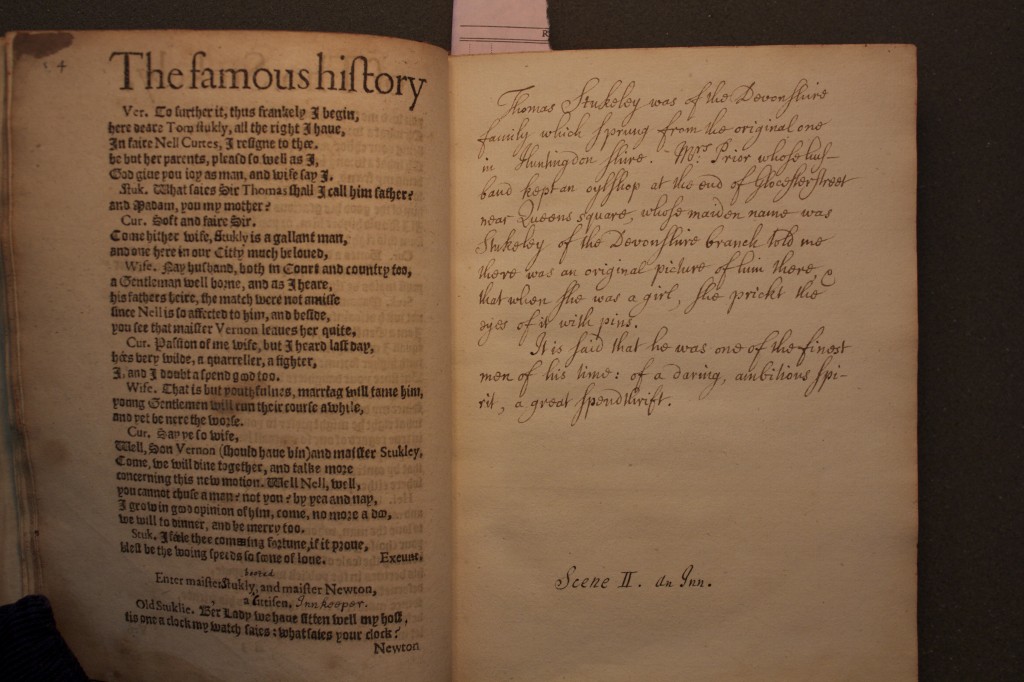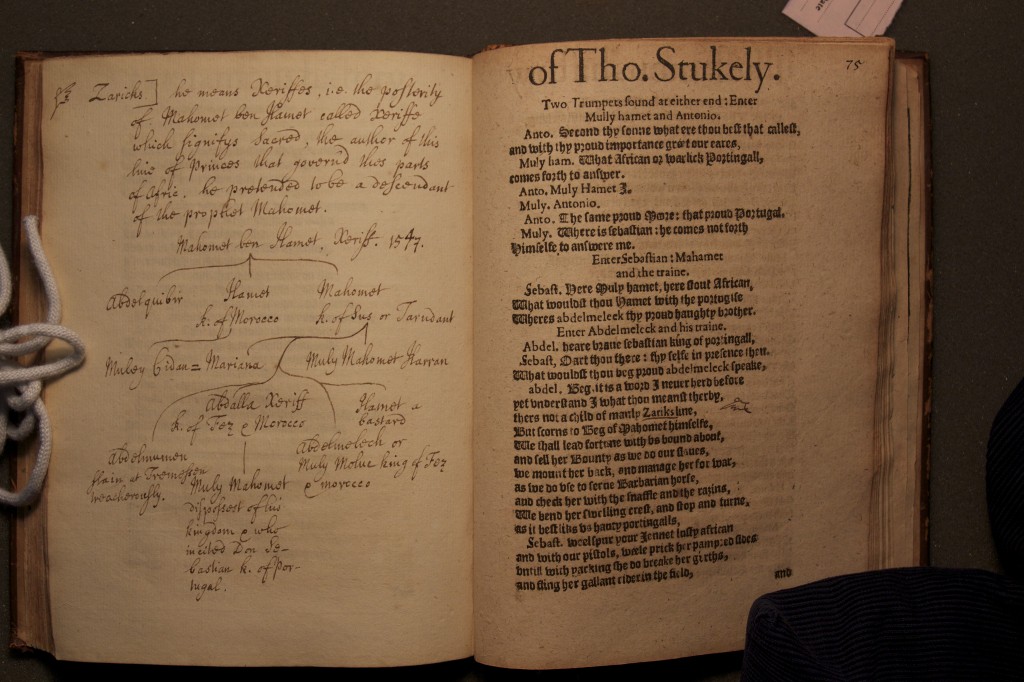Well-Read Plays III
Some readers, as I had mentioned in the previous post in this series, approached plays in thoroughly un-theatrical ways. In a sense, many of the marks and annotations I described in Part I also speak to a non-dramatic reception: underlinings, marginal crosses, asterisks, and other pointers, and even lines copied out in the margins or on the flyleaves are traces of a literary or textual understanding of plays — they don’t document a reader’s efforts at imagining either a staged performance or the virtual reality produced by such a performance. But the two instances below fall into a separate category altogether. In both cases, the readers quite explicitly ignored the dramatic nature of the texts, treating them instead as works of history or of political philosophy. As before, all images appear courtesy of the Folger Shakespeare Library in Washington, DC.
First off, a copy of Samuel Daniel’s controversial Philotas (STC 6239), printed in Daniel’s Certaine small poems in 1605 and performed at court by the Children of the Queen’s Revels late in 1604 — a performance that earned the poet a summons before the Privy Council when the portrayal of the eponymous Greek traitor was taken as a reference to the recently executed Robert Devereux, 2nd Earl of Essex (see Hugh Gazzard, “‘Those Graue Presentments of Antiquitie’: Samuel Daniel’s Philotas and the Earl of Essex,” Review of English Studies 51.203 [2000]: 423-450).
The owner of this volume can be identified as a contemporary of Daniel’s with some certainty. The book contains the bookplate of Anthony Grey, 11th Earl of Kent, and is signed on the title page, as you can see. The signature is that of the Earl of Kent’s maternal grandfather, Sir Anthony Benn (1570-1618), praised in verse by Ben Jonson (Underwood 33), knighted in 1617, and the Recorder of London at the time of his death. (The Folger’s cataloguers were understandably unsure about how to transcribe the signature, but I think it may be time to update the the entry.)
Benn treated Daniel’s text as a work of learning, writing, appropriately, in Latin, and referring to Horace, Juvenal, Plutarch, Seneca, and Tacitus in his marginal notes. On the play’s title page, he heaped praise on Daniel, proclaiming “spirat tragicum satis et faeliciter audet” — a quotation from Horace’s second epistle that translates as “he breathes enough of the tragic spirit and dares happily,” and suggests that this future judge may not have quite shared the Privy Council’s suspicions of Daniel’s purpose, though he recognized that the author was playing with fire.

Throughout the volume, Benn added references to classical precedents, noting where ideas in the text echo those of earlier writers. The purpose of these annotations is ambiguous: is the reader identifying the origins of Daniel’s lines? Or is he bolstering their authority by linking them explicitly to antiquity? Either way, what is the status of Daniel’s own text in this transaction? The following example illustrates well the complexity of the interaction between reader and book:

Benn marked Daniel’s lines with a trefoil (a frequently used commonplacing sign), but he then added, similarly trefoiled, a line, again from Horace’s second epistle: “Sedulitas stulte quem diligit urget” — “officiousness foolishly bothers the object of its affection,” indeed a likely source of Philotas‘s “For oft by an untimely diligence, / A busy faith may give a prince offence.” Are Daniel’s lines reduced to a mere translation in the act of annotation, then? Or does Benn’s identification of the author’s source (if that is what we’re looking at) highlight the principles of inventio and disposition in action — is he in fact paying homage to Daniel’s memorable refashioning of Horace’s Latin into an excerptable English phrase, now ready for future refashioning in another writer’s text? I would suggest that the notes here construct a specifically shared authority for the text: Daniel’s lines both have a status of their own (in what they add to the thought, and in how they reshape it) and a status that derives from their connection to a classical precedent, but neither necessarily trumps the other; hence the double trefoil.
Whatever Anthony Benn’s intention was, he did not treat Philotas as a contemporary play. He read the book as a form of philosophical discourse in dialogue with the classical tradition, and his annotations highlight this exchange between political philosophers. That the exchange is taking place within a tragedy seems almost negligible, despite the title-page reference to the “tragic spirit.”
My second example is later than most of the annotated plays I have discussed so far, but it’s so extraordinary that I thought I should make an exception. This is the Folger’s second copy of the 1605 quarto of the anonymous Famous History of the Life and Death of Captain Thomas Stukeley (STC 23405). The volume used to belong to William Stukeley (1687-1765), an antiquarian and (distant) relative of the play’s eponymous hero, and he annotated it extensively, probably in the 1720s. What is truly extraordinary about this book isn’t that it includes charming features like this “view of brother Williamsons house”:

No, the most remarkable aspect of the book is that it has been bound with interleaved blank sheets — this is a play that has been treated, materially, like a textbook or treatise, with as much space as possible for readerly notes and comments (about people poking the eyes of portraits out with pins, and the like):

And William Stukeley certainly made use of that space. Consider this page:

Stukeley picked up on the single word “Zarik,” marked it with a manicule, and then used the blank page to explain the term (or rather, what the term was a corruption of) and to provide a brief but fully annotated genealogy of the Saadian dynasty. On the one hand, this kind of commentary, like the very form of the volume itself, removes the play from its theatrical context altogether, treating it as a historical account in need of further historical explication. On the other hand, Stukeley’s notes anticipate to some extent the efforts of nineteenth-century and later editors — the most recent version of his genealogical chart can be found in Charles Edelman’s edition of The Stukeley Plays (Manchester 2005).
And it is worth noting that even as Stukeley read the play about his ancestor as an antiquarian, he also added notes that clarify the text’s theatrical logic:

The status of Thomas Stukeley here appears ineluctably ambiguous: it is a historical document and an occasion for scholarly engagement; but it is also a piece of drama, and as such needs to be understood through the performance conventions of its time, including frequent asides. William Stukeley could maintain both perspectives at once, reading the text as a source of knowledge and a challenge to his learning and simultaneously imagining the play as it might have been staged, with particular character speaking a particular way.
Next: what readers did to make their plays more legible.
- Click to email a link to a friend (Opens in new window)
- Click to print (Opens in new window)
- Click to share on Facebook (Opens in new window)
- Click to share on Twitter (Opens in new window)
- Click to share on Tumblr (Opens in new window)
- Click to share on LinkedIn (Opens in new window)
- Click to share on Reddit (Opens in new window)
- Click to share on Pinterest (Opens in new window)
One Response to Well-Read Plays III
Leave a ReplyCancel reply
Recent Comments
- Premodern Performance-based Research: A Partial Bibliography – Alabama Shakespeare Project on My Trouble with Practice-as-Research
- Premodern Performance-based Research: A Partial Bibliography – Alabama Shakespeare Project on Where is the Theatre in Original Practice?
- Alex on Steven Moffat, Sherlock, and Neo-Victorian Sexism
- Tim Keenan on Where is the Theatre in Original Practice?
- Holger Syme on 1920s Berlin Theatre: Research Marginalia 1
Archives
- November 2021
- April 2020
- March 2020
- October 2019
- January 2019
- December 2018
- November 2018
- October 2018
- March 2018
- February 2018
- January 2018
- July 2017
- May 2017
- March 2017
- November 2016
- October 2016
- September 2016
- August 2016
- June 2016
- May 2016
- January 2016
- December 2015
- November 2015
- October 2015
- September 2015
- August 2015
- July 2015
- June 2015
- May 2015
- February 2015
- January 2015
- November 2014
- October 2014
- September 2014
- August 2014
- July 2014
- May 2014
- April 2014
- March 2014
- February 2014
- January 2014
- November 2013
- October 2013
- September 2013
- August 2013
- July 2013
- May 2013
- April 2013
- March 2013
- January 2013
- December 2012
- November 2012
- October 2012
- September 2012
- August 2012
- July 2012
- April 2012
- March 2012
- February 2012
- January 2012
- December 2011
- November 2011
- October 2011
- September 2011
- August 2011
- July 2011
- June 2011
- May 2011
Copyright

Holger Syme's work is licensed under a Creative Commons Attribution-NonCommercial 3.0 Unported License.Images may be reused as long as their source is properly attributed in accordance with the Creative Commons License detailed above. Many of the photos here were taken at the Folger Shakespeare Library; please consult their policy on digital images as well.


Thanks much for this. These are fascinating.